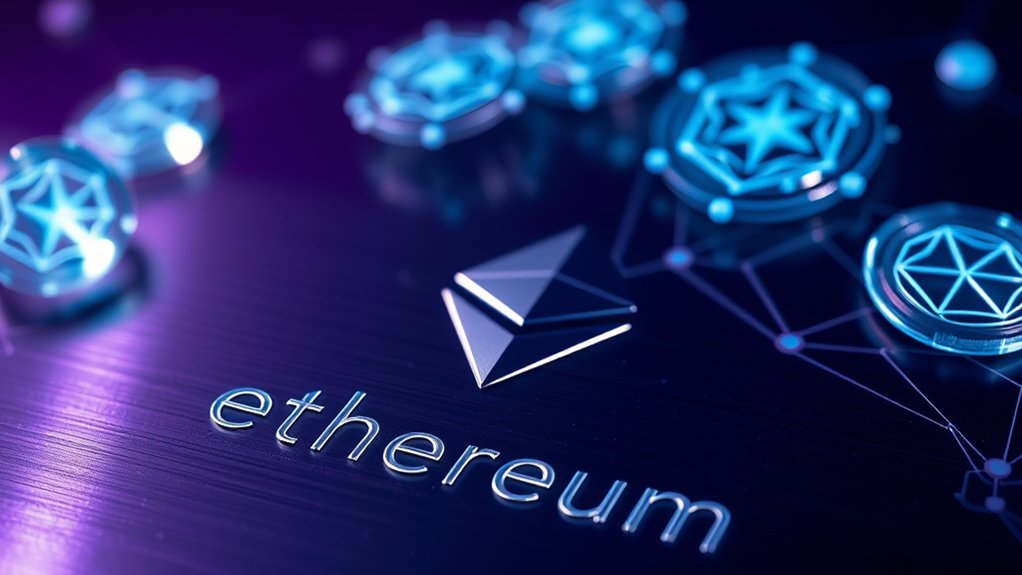ERC-20 tokens are like the bread and butter of the Ethereum blockchain. They define a standard for creating fungible tokens through smart contracts. Picture it: one token is just like another — no special snowflakes here. They’re used for everything from digital currencies to loyalty points. Sure, they sound great, but watch out for bugs and market volatility. Curious about how these tokens impact the crypto world? There’s a lot more to unpack.

ERC-20 tokens are like the bread and butter of the Ethereum blockchain. They are the backbone, the crucial building blocks, if you will. Defined by Ethereum Request for Comment #20, these tokens are fungible. That means one ERC-20 token is just like another. No special snowflakes here. They operate using smart contracts, which is just programmer lingo for automated agreements that dictate how these tokens behave on the Ethereum network.
Creating an ERC-20 token isn’t a walk in the park. Developers have to implement specific functions and events into the token’s smart contract. Think of it like following a recipe. If done wrong, you end up with a mess instead of a cake. ERC-20 tokens include six mandatory functions and two events that developers must incorporate to ensure proper functionality. Additionally, these tokens are transferable between wallet addresses, which enhances their usability and appeal in the decentralized applications space. These tokens often function as utility tokens that provide access to various services within their ecosystems.
But once it’s baked, these tokens are compatible with various Ethereum platforms and services. That’s a big deal. It fosters interoperability, making it easier for users to interact with different applications.
Now, let’s talk about some key functions. TotalSupply tells you how many tokens exist. BalanceOf shows you how much someone has. Transfer? That’s when you send tokens to a friend, or an enemy, depending on your relationships. There’s also TransferFrom and Approve, which allow for some fancy footwork in token transactions.
The advantages are clear. ERC-20 tokens are versatile. They can represent digital currencies, loyalty points, voting rights, and even physical assets. They’ve been adopted widely. You’ll find them on almost every crypto exchange.
But, it isn’t all sunshine and rainbows. There are risks. Smart contracts can be buggy. Market prices can swing wildly. Regulatory scrutiny? Yep, that’s a thing too.
Despite the challenges, ERC-20 tokens have had a massive impact. They’ve fueled the growth of the Ethereum ecosystem and sparked innovation. Sure, there are newer standards like ERC-777, but ERC-20 still holds its ground, dominating the scene.
Frequently Asked Questions
How Do I Create My Own ERC-20 Token?
Creating your own ERC-20 token? Easy-peasy, right?
First, sketch a plan. Decide what your token is for—fundraising, maybe? Then choose a snazzy name and symbol. Set your total supply and decimals, because who likes confusion?
Write smart contracts in Solidity or grab a no-code tool. Don’t forget about transaction fees; they’ll bite!
Finally, add some safety features. It’s a jungle out there—better be ready!
What Are the Benefits of Using ERC-20 Tokens?
The benefits of using ERC-20 tokens? Oh, it’s a whole mixed bag.
First off, they play nice with pretty much everything on Ethereum. Developers get to skip the compatibility headache and focus on cool features.
Plus, they’re super liquid, meaning trading them is as easy as pie. Want to plunge into DeFi? Good luck without ERC-20 tokens.
They can even help fund your next big idea. Talk about a toolbox for the modern world!
Can ERC-20 Tokens Be Exchanged for Fiat Currency?
Yes, ERC-20 tokens can be exchanged for fiat currency. Platforms like MoonPay make it pretty straightforward.
Users can buy or sell tokens using good old dollars, euros, or pounds. Top-ups? Easy peasy. Withdrawals can even come with zero fees.
But hey, don’t expect it to be flawless. Transaction costs can creep up.
Still, it’s a game changer for crypto enthusiasts desperate to turn digital coins into cash. Welcome to the future!
Are There Any Risks Associated With ERC-20 Tokens?
Risks? Oh, there are plenty. Smart contracts can be riddled with bugs—reentrancy attacks, anyone?
Wallets? They might just hand over your private keys to a hacker.
And good luck keeping up with market volatility; prices can plummet faster than a bad investment.
Phishing scams? Yeah, they’re lurking.
Plus, unclear regulations leave everyone in a fog.
Steering through this space is like walking a tightrope—without a safety net. Exciting, right?
How Do I Store ERC-20 Tokens Securely?
Storing ERC-20 tokens securely? It’s a wild ride.
Software wallets like MetaMask or Trust Wallet offer user-friendly access, but don’t get too comfy. They can be hacked.
Hardware wallets? Think Ledger or Trezor—great for offline security, but pricey.
Exchanges? Fast and convenient for trading, but good luck with long-term security.
Choose wisely. Trust is key, and remember: not all wallets support every token. So, do your homework.





